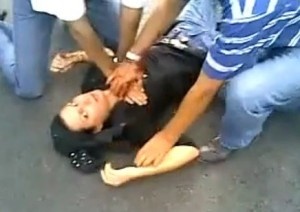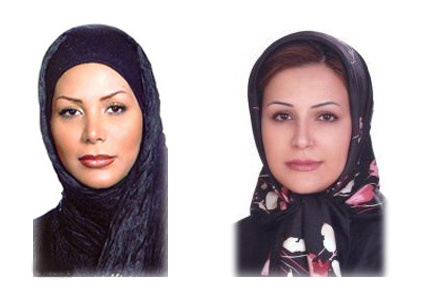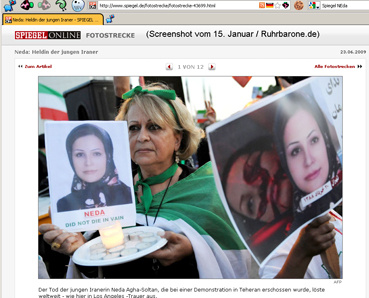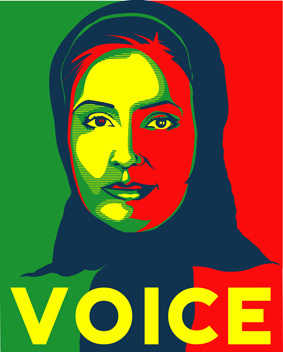// Um den Beitrag in deutsch zu lesen, klicken Sie bitte hier //
She who was presumed dead sat opposite me. She talked, she laughed, but sometimes I could feel her fear. Neda Soltani had to flee, she had to leave her homeland. Everything seems so different here at this obscure address near Frankfurt am Main – the snow, the frost, the rain, the inclement streets. It is a foreign country for this young woman.
Almost everyone in the world knows Neda Soltani’s picture. It appeared on TV and the Internet and in the newspapers in almost every house as the picture of someone who had died. This well-known portrait shows a young brown-eyed woman carefully made-up. The veil, obligatory in Iran, is pushed back slightly. One can see the beginnings of luxuriant hair. She smiles, gently, a bit innocent but friendly.
But right now, here in a café somewhere near Frankfurt Neda Soltani has become harder. She’s not wearing a veil anymore. One can see grey strands that are growing on her forehead. “It was a misunderstanding,” she says, “a mistake, an error with terrible consequences.” Neda Soltani got caught up in the tumult between the fronts after the fraudulent election in Iran. She was hounded, hunted and had to flee. Her old life fell apart like a shattered mirror. Her photo, that picture with the gentle smile, was torn from her.
Neda Soltani lived in Teheran up to half a year ago. She taught English Literature there. She speaks this language fluently, precisely and intelligently. In summer she completed a work on feminine symbolism in the works of Joseph Conrad. For that reason she had no time to take part in the protest in Iran. She had to do proof reading in June. “My aim was to become a professor one day, should I prove good enough for it.”
Her parents belong to the Iranian middle class. She does not want to say exactly where she grew up or what her family do. She is afraid. She is aware of the problems. She knows that things are not going well. But she was diligent when it came to learning. I was an academic, she says, “I worked hard for ten years to get a position as a lecturer in the university. I earned money, I went out with friends and I had fun.” She has none of that today. No work, no money and no friends to go out with. Neda Soltani is now 32 years old.
 The story of her photo began on June 20th 2009. That day a young woman was shot down near Kargar Avenue in Teheran at 7 p.m. local time. She fell on her back and blood ran out of her mouth. On doing so she stared into a mobile camara, wounded, terrified and helpless. She died shortly afterwards on the way to hospital. The pictures of the dying woman appeared on Youtube.
The story of her photo began on June 20th 2009. That day a young woman was shot down near Kargar Avenue in Teheran at 7 p.m. local time. She fell on her back and blood ran out of her mouth. On doing so she stared into a mobile camara, wounded, terrified and helpless. She died shortly afterwards on the way to hospital. The pictures of the dying woman appeared on Youtube.
The big TV stations soon got wind of the dying woman from Bloggers and Twitter. Editors tried to identify the woman. Pressed for time, they looked for pictures. Neda, her first name could be heard on Video. The internet quickly turned up a surname: Soltan, student at the Azad University in Teheran. Sombody used these data to search in Facebook.
Neda Soltani also had a profile there. There is not much accessible to the public in it. Only Neda’s friends had free access to the contents. But her photo was accessible at that time to every body.
It is not possible, anymore, to reconstruct who it was exactly who first gained access to the international portal for students, managers and housewives. It is also impossible to identify who it was who mistook the photo of Neda Soltani (below on the right) for that of the murdered Neda Soltan(below on the left).
 But the fact is that on the night of June 21st 2009 someone copied the photo of the living Neda Soltani from her Facebook profile. It was sent to all the social networks, blogs and portals. Soon it was being used by CNN, BBC, CBS, ZDF, ARD and every other conceivable station. It was printed in the newspapers and magazines of dozens of countries. It all happened simultaneously world wide.
But the fact is that on the night of June 21st 2009 someone copied the photo of the living Neda Soltani from her Facebook profile. It was sent to all the social networks, blogs and portals. Soon it was being used by CNN, BBC, CBS, ZDF, ARD and every other conceivable station. It was printed in the newspapers and magazines of dozens of countries. It all happened simultaneously world wide.
The photo of this young woman became the symbol of the freedom fight in the Persian Gulf. Furious people carried the picture of this alleged martyr before them in demonstrations. They carried it on their T-shirts and built alters to her. “The Angel of Iran” they called her.
How could it come to this photo swap? Soltani is a common name in Iran. Something like Miller probably. Neda is also not unusual. Somewhat similar to Sonja. The murdered Neda studied at the private Islamic Azad University, the living Neda Soltani was a lecturer there. Shouldn’t the media have done better research on the photo they were using instead of coping it directly from a Facebook profile and sending it around the world? Time was pressing, true, but one thing should have made them pause. The full name of the dead women was Neda Agha-Soltan. The name of the living Neda was simply Neda Soltani.
On the morning of 21st June 2009, the day after the shooting Neda Soltani was surprised by the number of people who wanted to register on her Facebook profile, allegedly as friends. There were hundreds from all over the world. They kept coming. There were telephone calls. A professor, a close friend, broke down in tears when he heard her voice.
At first Neda Soltani thought it was all a bad joke. Something that could be cleared up with two or three phone calls. A mistake that shouldn’t happen but then did. She began to write. She wrote that she was still alive. She wrote to the ‘Voice of America’, a popular broadcasting station in Iran. She told them that there had been a mistake, they had the wrong photo. She sent them her real photo as proof and asked the editors to make a comparison. Her photo was her. Neda Soltani never expected what then happened.
“Voice of America” broadcasted this new picture as a new picture of the dead Neda and CBS took it up. Neda Soltani got frightened. Everything she did to get back her true picture seemed useless.
 She took her photo out of her Facebook profile so that nobody could make more copies of it. The next stone began to roll. Suspecting a censure her photo was copied in dozens and hundreds of Facebook pages all over the world. Blogs fixed it and Twitter sent it.
She took her photo out of her Facebook profile so that nobody could make more copies of it. The next stone began to roll. Suspecting a censure her photo was copied in dozens and hundreds of Facebook pages all over the world. Blogs fixed it and Twitter sent it.
It was as if her own identity was subtracted from the photo and replaced by the longings of thousands of people. The smiling face of one presumed dead became the icon for an innocent victim in the freedom fight.
It was no help that on 23rd June 2009 genuine photos of the dead Neda Agha-Soltan were made available to all and sundry by her parents. Neda Soltani’s picture was still used.
Friends of Neda Soltani in Foren tried to correct the mistake. They were reviled with the words, “you bastards, you are not going to take the ‘Angel of Iran’ away from us.” It is as if a once believed-in mistake cannot be corrected.
This story is not just about a fiasco by the media in the artificial hectic they create when news gathering. This story also describes a cock-up created by the social media. The masses have the power in internet not only to expose lies, the masses can also create their own “truth” and defend it no matter how wrong. Few blogs bother to report the mistake. None of them had profile enough to be taken seriously.
The point came when it became clear to Neda Soltani that something had gone terribly wrong. Only a few journalists wrote to her about her Facebook profile and asked about her identity. None of them could or wanted to stop the deception.
Pressure was put on Neda Soltani in Iran. She was threatened. She feared for her family, for that reason she is not willing to say what exactly happened. Only one thing was clear: the mistake made with her photo should be used by every means possible against the opposition, the people on the streets should be revealed as instruments of western agents. Odious reproaches were made that could have meant death. Neda became ill, panic attacks and helpless fear became part of her life.
She couldn’t stay any longer. She had to disappear out of Iran. She fled to the west on July 2nd 2009 without saying farewell to her parents. She had to use her savings to pay her helpers. She fled with nothing in her hands except a rucksack, a small rucksack. She fled via Greece to Germany. She had a cousin here in Bochum. That is now her family.
Eventually the BBC Online reported the false identity on 3rd July 2009 in a weekly column about social networks. It was published directly after a report on the conspiracy theories about Michael Jackson’s death. The BBC commented, that this case was an excellent example of the danger involved when the mass media use pictures taken from the social networks.
One would have thought that that was the end of it. “My friends said, wait a day and all will be well. But days passed and nothing was good,” said Neda Soltani.
Her application for political asylum in Germany is in process for months. Neda says she never wanted to go abroad. She had never been in the west. She has homesickness. She gets about Euro 180 a month from the German state. That is barely enough to buy salads, fruit and bread which is what she was used to. She lives somewhere in a home for refugees. Her room, number eleven, is small, has two beds and a shelf. She lets nobody in. She wants to forget these months ‘in camp’ as quickly as possible. As soon as she is out she wants to completely forget it. The metal fittings on her door have been patched with plaster. There is no window in the kitchen for the two dozen people on the whole floor. The water tap clings to a shelving construction. There is a satellite dish attached to a broken metal bar on the balcony above the yard. The bar is stuck into a shabby sauerkraut bucket full of sand and stones, an improvised contraption for the connection to the homeland.
 Although the photo of the dead Neda has been known for months the wrong picture still appears in Spiegel-Online, in the New York Times and in the Online edition of the Süddeutschen Zeitung. Even the AFP news agency used a version of the picture.
Although the photo of the dead Neda has been known for months the wrong picture still appears in Spiegel-Online, in the New York Times and in the Online edition of the Süddeutschen Zeitung. Even the AFP news agency used a version of the picture.
Almost all of these pictures have one thing in common: often they are photos taken by photographers. They show people inserting an icon into a camera. They are photos of a wrong picture.
Neda Soltani remained silent about this for a long time. She wanted to get her feet on the ground again, to collect herself.
In November CNN made a report on Iran; they used Neda Soltani’s picture again. She wrote to CNN and asked them to erase her picture.
The answer she got was an automatic Email asking for her understanding that not all enquiries could be personally answered. The Email was signed “CNN, The Most Trusted Name In News.”
Her picture doesn’t belong to her anymore. It belongs to CNN and all the others.
——
Translation: Hugh Murphy



[…] This post was Twitted by revmagdalen […]
https://digg.com/d31HuP8
This article has several mistakes, Neda Soltani is sometimes spelled as Nada Soltani, please fix this.
Hi Anna,
Thanx for the hint. It’s fixed now, sorry!!
This blog post (or translation of an earlier article or post) does not make the source clear. Who is the author and when and where was it originally published?
I refer to the paragraph: „…right now, here in a café somewhere near Frankfurt Neda Soltani has become harder. She’s not wearing a veil anymore. One can see grey strands that are growing on her forehead. “It was a misunderstanding,” she says, “a mistake, an error with terrible consequences.”
When was „right now“? This rambling blog post is dated February 4, 2009, and yet it refers to events that must have happened later in the year. Was this woman actually interviewed in Germany, and if so, when… and by whom?
Hi Tony,
thank you for your questions.
I’m the author of this piece. David Schraven. It says so in the authors-line. It was translated by Hugh Murphy.
I’m a jounalist working in Germany. The story was also published in SZ Magazin, the weekly Supplement of Süddeutsche Zeitung – something like the German New York Times.
It was published last friday 5th of february.
The post seems to be from last Year, because I dated it back in wordpress to not confuse our german readers. The German Version of this text was also published last friday 5th of february. If I had not dated back the english version, the same text would have appeared twice the same day. Once in German and once in English. Some readers wouldn’t understand that either. 🙂
I thought it was better to date the english draft back one year.
And as it says in the text. I interviewed Neda Soltani in Germany in a town near Frankfurt/Main – almost two weeks ago.
Best David
Da soll wohl etwas manipuliert werden. Wer ein wenig Sinn für Gesichtssymetrie hat kann erkennen, daß die Frauen auf den gezeigten Photos nicht die gleichen sein können. Dazu weichen Mund- und Augenpartien, die Kinnpartien wie auch die gesamte Gesichtsform (das eine ist breiter) zu stark voneinander ab. Das Kann nicht auf den Effekt der verschiedenen Kopftücher zurück zu führen sein.
Die Legende ist (mit Absicht) zu stark „gestrickt“.
This story has some errors. I wrote an article on June 24, 2009, just days after Neda’s death, called „Not That ‚Neda‘ – How the Wrong Photo Became an Icon, published online, to correct the error and personally contacted an editor at the New York Times and a senior producer at CNN regarding this to alert them that they were using the wrong photo, and both took action to correct it. The story would have made it on the Rachel Maddow Show on MSNBC later that week to give it more media exposure and publicity, except the death of pop star Michael Jackson eclipsed it. I worked tirelessly contacting many media outlets to get them to remove the picture in the months since then, and have been in contact with the living Neda Soltani regarding this. It is not true that no one did anything or that the media did not respond. There are some still using the photo in error, yes, but I was at least one person who worked with diligence to get that corrected, and it isn’t correct that no one had weight enough to make a difference. I had personal contact with both the editor and producer in question above, and it did make a difference. Neda Soltani’s story is a tragic one, however, and should never have happened, and absolutely should never have had the consequences it did in an innocent person’s life.
Not That ‚Neda‘ – How the Wrong Photo Became an Icon
https://open.salon.com/blog/kathy_riordan/2009/06/23/not_that_neda_-_how_the_wrong_photo_became_an_icon
I communicated with the living Neda Soltani in the early hours of June 21, 2009, right after I viewed the YouTube video of the shooting of Neda Agha-Soltan, the Neda who was killed. Neda Soltani and I „friended“ each other on Facebook. Within 4 hours her photo raced around the world. As soon as I contacted one web site or media outlet to tell them it was the wrong woman, 5 more posted it. By morning I told Neda it was too late. We would just have to let the story die out in a few days. It took weeks. As recently as Jun 12, 2010, FOX TV ran an interview with the fiance of the dead Neda and willfully used the photo of the living Neda. This is libelous and I do hope Neda Soltani stops asking for correction and starts suing for damages.
Neda and I met in Greece after she fled Iran. There is much more to her story that she is not ready to tell and I have kept my silence at her request. But I want to emphasize that I and 2 or 3 other people worked around the clock for days in June 2009 to extinguish this erroneous use of her photo. I personally spoke with many journalists including one from the NY Times to inform them of the error. The very next day the New York Times ran Neda Soltani’s photo in spite of having knowledge that it was of a living woman.
Within hours of the shooting video being uploaded to YouTube, I sent an SMS text message to Joe Johns, a well-known CNN reporter, on his private mobile number, warning him that the photo was of a living woman and not to use it. I have known Joe for over 20 years. CNN ran her photo anyway the next day.
The list goes on. So what I REALLY want to emphasize is that mainstream media no longer cares (maybe NEVER cared) about accuracy in reporting. They care about ratings. They all copy the „facts“ from one another. Many of the smaller newspapers and TV stations and online websites used the logic „How can CNN, FOX, MSNBC, BBC ALL be wrong about the Neda photo?“ If THOSE stations said the photo was of the dead woman, then they must be right. . .that was how so-called journalists „checked“ their facts.
In contacting hundreds of websites to correct the mistake, the comment box was too small for a thorough explanation, so I blogged about the mistake in June 23, 2009, in my effort to help correct the mistake and then I posted the link: https://wipoun.blogspot.com/ . Then that blog was spread across the internet by others.
It was a journalist with BBC who read my blog and interviewed me. She finally wrote a story for BBC to correct the error and asked for Neda to appear on TV, but Neda was traumatized, afraid for her family, in hiding and unwilling to appear on TV. The correction was too late for Neda Soltani. On June 20, 2009, the lives of two Neda’s were destroyed, one by a bullet, one by western media.
I turned my TV off two years ago and now rely on reading news on the internet. I’ve never been so well-informed in my life.
Dear Kathy, Dear Amy,
I think it was good, that you tried to make the difference, but it was useless.
And that’s the point.
To many people believed in the wrong picture. Because the social and the mass media showed them, what to believe in.
That’s it.
Of course, there was the truth always availably. But only few people like you cared about it.
Dear David,
It wasn’t useless. It did make a difference. It might not have wiped out every use of the wrong photo, but it wiped out many of them. I saw it make a difference. I know CNN pulled the photo when I talked to a senior producer. I know the NY Times pulled the photo when I talked to an editor. I haven’t seen either use it since. But it is like a dam of water breaking; you can’t get all the water back in after you fix the dam, some will have escaped. That there were people who cared enough to devote hours to helping fix this is important. I continue to contact people when I see the wrong photo being used.
It is true and unfortunate that there was more than one casualty to that sniper’s bullet. The loss Neda Soltani has sustained is incredible and largely invisible to the world, yet she maintains her dignity.
Hi Kathy,
you changed one or two, maybe three pictures. Maybe four or five or six.
But you didn’t changed all of them.
Just an example: Even CNN was using the wrong picture in a story, that was broadcast in November 2009. Although you claimed, you changed everything for good.
Sorry, but that is wrong,
By the way. I think it is good, to try to helping fix the problem. It’s not futile. But in this case, the mistake was so big, that nobody could fix it in time.
I changed more than you can possibly imagine. Talking personally to the senior producer at CNN made a significant difference in their use of the photo. I contacted dozens of organizations and got them to stop using it, and if we’d gotten the story on MSNBC as planned (before the Michael Jackson death prevented it), it would have changed many more. Here I am trying even now to change the use of it, a year later, and have never stopped doing that.
I didn’t change two or three uses of the picture. I changed as many as would listen, and that was in the high dozens. I don’t think anyone has been as vigilant in doing that except Neda herself. If I hadn’t contacted CNN, the use would be far more widespread. Ditto with the NY Times. In both cases I had people I knew there, personal contacts, and it did make a difference.
The only ones I can’t change are those who won’t listen, but it isn’t for lack of contacting them. I notice on a recent Press TV piece they are using it alongside a picture of Neda Agha-Soltan, but I doubt they would listen to me.
Neda Soltani needed people to stand up for her and be a voice for her even when she couldn’t, and she still needs that today. For everyone trying to get her image corrected, it is a good thing, but it will never restore to her what she has lost.
This part of the story that has been told so far, is only the beginning of the story. I am confident that Neda Soltani one day will tell the entirety of her story herself. Sometimes it takes years for a story to be told.
Ahmad Batebi is an Iranian who was arrested, tortured, and imprisoned for 9 years after his photo appeared on the cover of the Economist magazine. The photo, which has been called „an icon for Iran’s student reform movement,“ was taken during the Iranian student protests in July 1999 in Tehran. Following its publishing, Batebi was arrested, tried in closed-door proceedings, found guilty of „creating unrest,“ and sentenced to death. In the famous photo he was holding up a bloodied t-shirt from his friend who had been shot during street anti-government demonstrations. While imprisoned, he was pressured to confess that the red spots on the t-shirt were not blood. He refused to confess. He escaped in 2008 after nearly nine years of imprisonment and was granted asylum in the U.S. He finally told his story on 60 Minutes in 2009. Neda Soltani knew of Batebi’s plight and had every reason to fear enough to flee Iran for her own safety.
[…] The story of Neda Soltani – A story of what media can do to an One can see the beginnings of luxuriant hair. She smiles, gently, a bit innocent but friendly.. The pictures of the dying woman appeared on Youtube..www.localhost/rb/the-story-of-neda-soltani-a-story-of-what-media-can-do- to-a-person/ – The story of Neda Soltani – A story of what media can do to an […]
she was my instructor at university. she was a successful girl but MEDIA didnt let her go on her way. who cares? they ruined her life but now they dont even help her have a normal life.
[…] camp. Today, she is pursuing a fellowship at a University in the United States. According to Ruhrbarone a German journalism blog, Ms. Soltani’s picture was used widely by CNN, BBC, CBS, Fox […]